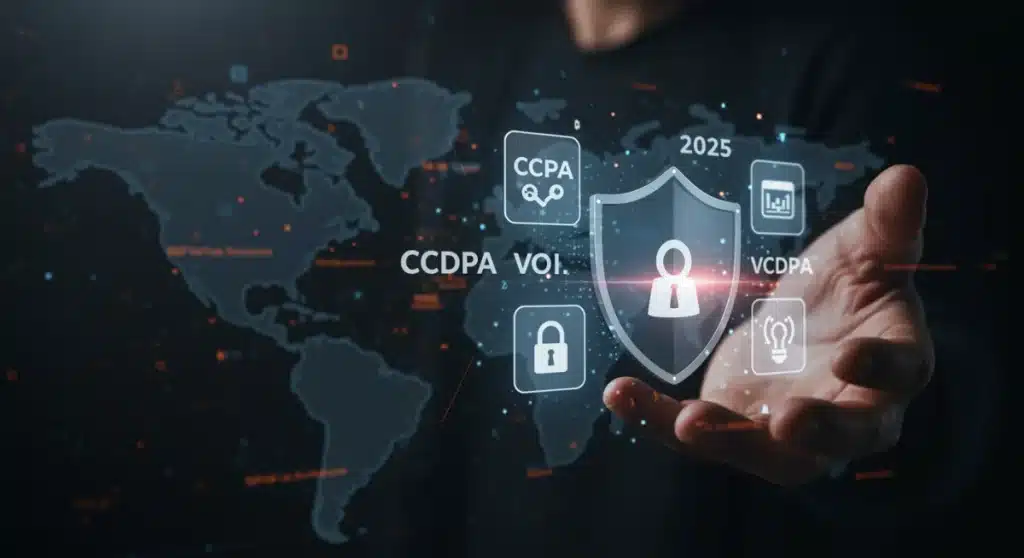Optimizing Digital Privacy Policies for US Consumers: A Practical Guide to CCPA and VCDPA Compliance by Q1 2025

Optimizing Digital Privacy Policies for US Consumers: A Practical Guide to CCPA and VCDPA Compliance by Q1 2025 is shaping today’s agenda with new details emerging from officials and industry sources. This update prioritizes what changed, why it matters, and what to watch next, in a clear news format.
Optimizing Digital Privacy Policies for US Consumers: A Practical Guide to CCPA and VCDPA Compliance by Q1 2025 is not just a regulatory deadline; it represents a pivotal shift in how businesses handle personal data. As Q1 2025 approaches, companies operating in the US, particularly those engaging with consumers in California and Virginia, face critical updates to their data privacy frameworks. This guide delves into the essential steps for navigating these complex requirements and ensuring robust compliance.
Understanding the Evolving Landscape of US Digital Privacy
The digital privacy landscape in the United States continues its rapid evolution, driven by increasing consumer demand for data control and legislative action. The California Consumer Privacy Act (CCPA), as amended by the California Privacy Rights Act (CPRA), and the Virginia Consumer Data Protection Act (VCDPA) stand as two of the most comprehensive state-level privacy laws. Their upcoming compliance benchmarks by Q1 2025 necessitate a proactive approach from businesses.
These regulations are designed to empower consumers with greater rights over their personal information, including the right to know, access, delete, and opt-out of the sale or sharing of their data. For businesses, this translates into significant obligations regarding data collection, processing, storage, and disclosure. Failure to comply can result in substantial penalties, reputational damage, and erosion of consumer trust. The urgency surrounding Q1 2025 stems from clarifications and enforcement ramp-ups that require immediate attention to existing policies and practices.
Key Provisions of CCPA and VCDPA Affecting Businesses
The CCPA and VCDPA share common goals but possess distinct nuances that demand careful consideration. Both laws establish fundamental consumer rights and impose obligations on businesses concerning data handling. Understanding these core provisions is the first step toward effective US Digital Privacy Compliance.
Consumer Rights Under CCPA and VCDPA
- Right to Know: Consumers can request information about the personal data a business collects, uses, shares, or sells.
- Right to Delete: Consumers can request the deletion of their personal data collected by a business.
- Right to Opt-Out: Consumers have the right to opt-out of the sale or sharing of their personal data.
- Right to Correct: VCDPA specifically grants consumers the right to correct inaccuracies in their personal data.
- Right to Limit Use of Sensitive Personal Information: CCPA/CPRA allows consumers to limit the use and disclosure of sensitive personal information.
Businesses must establish clear, accessible mechanisms for consumers to exercise these rights, such as dedicated web forms or toll-free numbers. The response timelines are strict, typically requiring action within 45 days of a verifiable consumer request. This operational requirement often necessitates significant internal process adjustments and staff training.
Strategic Steps for Achieving Compliance by Q1 2025
Achieving compliance with CCPA and VCDPA by Q1 2025 requires a multi-faceted strategy that addresses legal, technical, and operational aspects. Procrastination is not an option, as the implementation of robust privacy frameworks can be time-consuming and complex.
The journey to compliance begins with a thorough assessment of current data practices. This includes mapping all data flows, identifying what personal information is collected, where it is stored, how it is processed, and with whom it is shared. Such an audit helps pinpoint areas of non-compliance and guides the development of a remediation plan. Many organizations find that their initial data mapping efforts reveal unexpected data redundancies or unapproved data sharing practices.
Conducting a Comprehensive Data Audit and Mapping
A detailed data audit is foundational for effective US Digital Privacy Compliance. This process involves:
- Inventorying Data: Cataloging all types of personal information collected, including identifiers, sensitive data, and inferences.
- Data Flow Mapping: Documenting the journey of data from collection points through processing, storage, and sharing with third parties.
- Vendor Assessment: Evaluating third-party vendors and service providers to ensure their data handling practices align with CCPA and VCDPA requirements.
- Risk Assessment: Identifying potential privacy risks and vulnerabilities within data processing activities.
This comprehensive view allows businesses to understand their data footprint and ensure that all personal information is handled in accordance with the law. Without a clear understanding of data flows, it becomes nearly impossible to respond accurately to consumer rights requests or to identify potential data breaches effectively.

Updating Privacy Policies and Consent Mechanisms
Once data practices are understood, updating privacy policies and consent mechanisms becomes paramount. Transparency is a cornerstone of both CCPA and VCDPA, meaning consumers must be clearly informed about data practices in an easily understandable manner. This goes beyond simply having a privacy policy; it requires active communication and user-friendly interfaces.
Your privacy policy must explicitly detail the categories of personal information collected, the purposes for which it is used, and whether it is sold or shared. For sensitive personal information, stricter consent requirements apply. Businesses must also provide clear instructions on how consumers can exercise their privacy rights. Furthermore, websites must prominently display a “Do Not Sell or Share My Personal Information” link, or similar mechanisms as required by specific state laws.
Implementing Robust Consent Management Platforms
Effective consent management is crucial for US Digital Privacy Compliance. This involves:
- Granular Consent Options: Allowing consumers to provide specific consent for different types of data processing activities.
- Record Keeping: Maintaining detailed records of consumer consent choices, including when and how consent was given.
- Easy Withdrawal: Providing simple mechanisms for consumers to withdraw consent at any time.
- Cookie Banners: Implementing compliant cookie banners that inform users about data collection through cookies and offer clear choices.
A well-implemented Consent Management Platform (CMP) can automate many of these processes, ensuring consistency and reducing the administrative burden on businesses while guaranteeing legal compliance. This technology solution becomes increasingly vital as data collection methods become more sophisticated across various digital platforms.
Operationalizing Consumer Rights Requests and Data Security
Compliance extends beyond policy updates to the operationalization of consumer rights requests and the implementation of robust data security measures. The ability to promptly and accurately respond to requests to know, delete, or opt-out is a key indicator of an organization’s compliance maturity.
Businesses must establish clear internal procedures for receiving, verifying, and fulfilling consumer requests. This often involves cross-departmental collaboration, staff training, and potentially new technological solutions to manage these workflows efficiently. Verification processes are critical to prevent unauthorized access to personal data. Alongside this, strong data security practices are non-negotiable; both CCPA and VCDPA imply a duty to protect personal information from unauthorized access, use, or disclosure.

Enhancing Data Security Protocols
To meet the security expectations of CCPA and VCDPA, organizations should focus on:
- Encryption: Encrypting personal data both in transit and at rest.
- Access Controls: Implementing strict access controls to limit who can view and process personal information.
- Regular Audits: Conducting regular security audits and penetration testing to identify and address vulnerabilities.
- Incident Response Plan: Developing and regularly testing a comprehensive data breach incident response plan.
These security measures are not just about avoiding penalties; they are about building and maintaining consumer trust, which is invaluable in the digital economy. A proactive stance on data security minimizes the risk of breaches and demonstrates a commitment to protecting consumer privacy, a core element of US Digital Privacy Compliance.
Preparing for Enforcement and Future Amendments by Q1 2025
As Q1 2025 approaches, enforcement of CCPA and VCDPA is expected to intensify. Regulatory bodies, such as the California Privacy Protection Agency (CPPA) and the Virginia Office of the Attorney General, are actively monitoring compliance and are prepared to issue fines for violations. Businesses must stay abreast of enforcement trends and be ready to demonstrate their compliance efforts.
Beyond current regulations, the digital privacy landscape is constantly evolving. Other states are considering or have enacted their own privacy laws, creating a patchwork of regulations across the US. Businesses with a national presence must anticipate future legislative changes and build flexible privacy programs that can adapt to new requirements. Continuous monitoring of legal developments and engagement with privacy experts are essential for long-term compliance.
Proactive engagement with privacy counsel and industry groups can provide invaluable insights into emerging best practices and regulatory interpretations. This forward-looking approach ensures that businesses are not just reacting to current laws but are strategically positioning themselves for the future of digital privacy. The deadline of Q1 2025 serves as a critical checkpoint, but the commitment to consumer privacy is an ongoing journey.
Key Compliance Area |
Action Required by Q1 2025 |
|---|---|
Data Audit & Mapping |
Complete inventory of personal data, flows, and third-party sharing. |
Privacy Policy Updates |
Ensure policies clearly inform consumers about data practices and rights. |
Consent Management |
Implement granular consent mechanisms and maintain robust records. |
Consumer Rights Response |
Establish processes for timely and accurate handling of requests. |
Frequently Asked Questions About US Digital Privacy Compliance
▼
While both grant consumers data rights, CCPA (as amended by CPRA) applies
to for-profit entities meeting specific revenue/data thresholds, while
VCDPA applies to businesses processing data of at least 100,000 consumers
or 25,000 with 50% gross revenue from data sales. VCDPA also includes a
right to correct inaccuracies, which CCPA does not explicitly detail.
▼
“Sale” generally refers to exchanging personal information for monetary
or other valuable consideration. “Sharing” specifically refers to
disclosing personal information for cross-context behavioral advertising.
Both activities require providing consumers with an opt-out mechanism,
often via a “Do Not Sell or Share My Personal Information” link.
▼
Sensitive personal information includes data like racial or ethnic
origin, religious beliefs, health information, precise geolocation, and
biometric data. Under CCPA/CPRA, consumers have the right to limit the
use and disclosure of this information, requiring businesses to offer a
clear option for consumers to exercise this right.
▼
Penalties can be substantial. For CCPA/CPRA, civil penalties can reach
$2,500 per violation or $7,500 for intentional violations, and up to
$750 per consumer per incident for data breaches. VCDPA also allows for
penalties up to $7,500 per violation, enforced by the Virginia Attorney
General, making compliance critical.
▼
Not necessarily. While these laws have applicability thresholds based on
revenue, consumer data processed, or data sales, many small businesses
may still fall under their scope, especially if they operate online and
collect consumer data from California or Virginia residents. It’s crucial
to assess your specific situation against the thresholds.
Looking Ahead: The Future of US Digital Privacy
The impending Q1 2025 compliance window for CCPA and VCDPA marks a significant milestone in the ongoing evolution of US Digital Privacy Compliance. Businesses that actively engage in optimizing their digital privacy policies now will not only mitigate legal risks but also build stronger, more trustworthy relationships with their consumers. As more states introduce their own privacy legislation, a robust and adaptable privacy framework will be key to success in the increasingly regulated digital economy. Staying informed and proactive remains the best defense against future challenges and the best strategy for fostering consumer trust.





